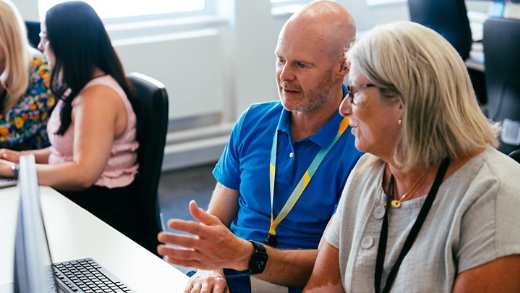Our accessibility intent
‘That was easy!’
... is what we want everyone to say about using our website.
We design and build to meet W3C Web Content Accessibility Guidelines (WCAG) 2.2 at a conformance level of AA. Our accessibility experts and Accessibility Manual help us achive this. With few exceptions, we already do things like:
- checking visitors can use our site using keyboard navigation
- getting accessibility advice before introducing new functionality
- offering transcripts and captions for videos, and avoiding auto-play video
We're working to improve how our content is structured and signposted. We’re also trying to reduce our use of PDFs and make the ones we offer more accessible.
Good accessibility helps everyone, including people with disabilities, neurodiversity, and those in vulnerable situations.

How to adapt our website to suit you
Online text size
To change the text size in your internet browser, or to magnify your screen, first go to the Settings menu in your browser. You’ll usually find the option to change the text size under Preferences, View or Appearance.
You can find more detailed guides for the most popular web browsers below.
- How to change text size on Microsoft Edge
- How to change text size on Safari
- How to change text size on Google Chrome
Text-to-Speech
If you need text-to-speech support, screen reader or read-aloud software may help.
Most browsers have a text-to speech function in their Settings menu. Turn this on and your device will read out the on-screen text. This functionality is also known as read aloud, read mode or reader view.
Our website supports screen readers such as NVDA, VoiceOver and Narrator.
Online help from AbilityNet
AbilityNet have a range of resources aimed at making the web more accessible. They have step-by-step guides to adapt your phone, computer or tablet to make it easier to use online. For more information head to the AbilityNet My Computer My Way website.
Are you a customer?
Discover how you can access our services.
Hear from our colleagues
Harri, quality assurance analyst and member of Aviva’s Ability Community, Aviva UK:
"I live with ADHD and dyslexia, so reading and retaining information is more difficult than I’d like. Complicated websites, overwhelming amounts of information, and even certain fonts can be impossible for me.
I’m helping to make sure that people who are visually impaired, neurodivergent, non-English speaking, really any person from any walk of life, can find what they’re looking for on aviva.com without difficulty or stress."
Taryn SEO manager & digital accessibility lead, Aviva Ireland:
"Ensuring digital accessibility for the aviva.ie website is crucial because it allows everyone, including those with disabilities and the elderly, to access the same information and services.
This inclusivity makes it easier for more people to use our websites, aids compliance with legal standards, and improves our brand reputation."
Alison, group external reporting planning manage, Aviva UK:
"Ensuring the accessibility of reporting PDFs on aviva.com is incredibly important to me.
I want everyone, regardless of their abilities, to be able to engage with and understand the information we present. This, in turn, helps our stakeholders feel valued and informed.
We, as a team, have worked hard to try and make our reports more accessible, and will continue to build on this for future reporting cycles."
Contact us about the accessibility of our website
Are you having accessibility issues using our website?
Have you got suggestions for how we can improve?
Email webaccessibility@aviva.com and we’ll get back to you within five working days.
For general enquiries about aviva.com, it’s best to email: corporatewebsite@aviva.com.

